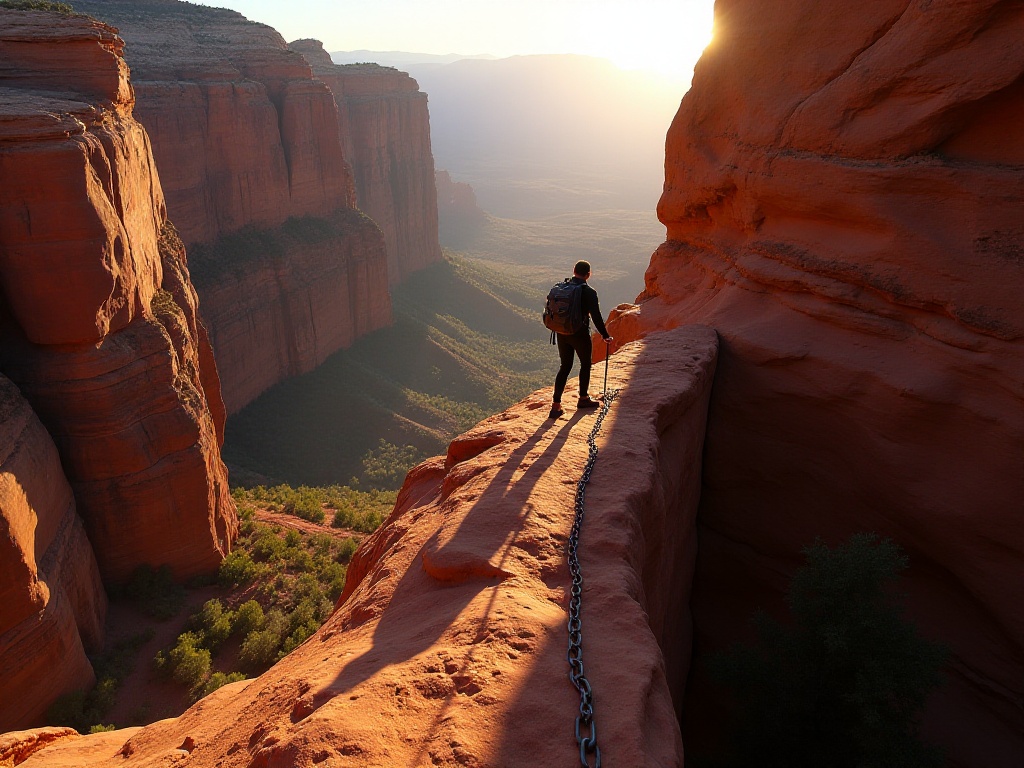Introduction
Hello everyone! I've noticed that more and more friends are becoming interested in hiking lately. As a travel blogger who has explored far and wide, I often receive private messages asking: "How should I choose a trail for my first hike?" "I want to challenge myself, what routes do you recommend?" Today, I'll share with you these captivating hiking paradises, along with my personal experiences and unique insights.
Song of Ice and Fire
When it comes to breathtaking hiking trails, Iceland's Laugavegur Trail is absolutely top-tier. This trail, known as the "Song of Ice and Fire," is nature's most perfect work of art. I explored this area last summer, and the overwhelming feeling still lingers in my memory.
Can you imagine? The experience of walking this trail is simply magical! You're stepping on black volcanic ash while looking up at white glaciers - the visual contrast is truly stunning. I remember one time when I was walking through a geothermal area, a geyser suddenly erupted in the distance. That moment moved me to tears; nature's craftsmanship is truly awe-inspiring.
This trail is best hiked between June and September when the weather is relatively stable and daylight hours are long. I recommend setting aside at least 4-5 days because there are so many beautiful scenes along the way - you could spend an entire day just taking photos. There are many geothermal hot springs along the route; soaking in one after a tiring hike feels absolutely amazing.
The accommodation conditions along the way are actually quite decent, with many mountain huts available for rest. However, I must remind everyone to book in advance as they're extremely popular during peak season. On my first trip, I had to sleep in a tent because I couldn't secure a hut reservation - while it was a different kind of experience, it was quite tiring.
The terrain varies greatly, sometimes walking on flat volcanic ash, other times crossing rapid rivers. I remember once while crossing a river, the current was so strong I almost got swept away, fortunately, I grabbed the safety rope in time. So waterproof hiking boots are essential, preferably high-top ones to protect your ankles.
Weather changes are also a major challenge. Sometimes it's sunny in the morning but raining or even snowing in the afternoon. From my experience, you must bring enough warm clothing and prepare waterproof outerwear. I recommend layering your clothes so you can adjust according to the weather.

Peak of the East
Speaking of classic hiking trails, Japan's Mount Fuji is absolutely worth mentioning. Timing is crucial - I recommend going between July and September during the official climbing season. My first visit was in mid-August, when the weather was perfect and visibility was excellent throughout the journey.
The climb from the 5th station up is really interesting. You meet hikers from all over the world, and despite language barriers, everyone encourages each other when they see someone struggling - the atmosphere is particularly warm. Did you know? Many people start climbing at midnight just to watch the sunrise from the summit. Although night climbing is exhausting, when you stand at 3,776 meters and watch the sun rise from the sea of clouds, that feeling is truly indescribable.
The biggest challenge during the climb is probably altitude sickness. I remember during my first summit attempt, I started feeling dizzy and nauseous at the 8th station and almost gave up. Later, a Japanese gentleman taught me to slow down, take deep breaths, and even shared his oxygen bottle with me. So I recommend everyone to prepare some medication for altitude sickness, and maybe carry a small oxygen bottle if necessary.
Mount Fuji's weather loves to play games. I've seen many people climbing in short sleeves and shorts, only to end up shivering at the summit. I recommend bringing warm clothing even in summer, as temperatures at the summit are often below freezing. It also rains frequently, so waterproof gear is essential.
Supplies aren't a major concern. Every mountain hut from the 5th station to the summit sells food and water. However, prices are quite high - a bottle of water might cost 500 yen. I suggest bringing enough food and water from the bottom to save money.
What impressed me most was the descent. Many people think going down is easier than going up, but that's not the case. Fuji's descent trails are covered in loose volcanic gravel, making it easy to slip. My descent took nearly 5 hours, and my knees were almost destroyed. So I recommend bringing hiking poles to reduce knee strain.

South American Legend
If you want to truly challenge yourself, Argentina's Mount Fitz Roy is definitely worth trying. This peak, known as the "King of Patagonia," is no joke. The local weather changes are even more dramatic than Mount Fuji's - you can experience all four seasons in one day.
When I hiked there last year, I encountered super dramatic weather. It was sunny when we started in the morning, snowing by noon, and windy in the afternoon. But it's precisely this variable weather that creates Fitz Roy's unique beauty. When you look up at it from the base, the feeling is truly indescribable.
This trail is indeed challenging. First, there's the terrain variation - sometimes you're climbing steep rock faces, other times crossing glaciers. I remember one particularly dangerous section where we were practically walking along a cliff face - one wrong step could mean a fall. So it's essential to hire experienced guides who know which areas require special attention.
Equipment requirements are also high. Besides standard hiking gear, you need crampons and climbing ropes. During my first visit, I wasn't adequately equipped and got stuck on a glacier section for a long time. Fortunately, I met a French couple who lent me their spare crampons, allowing me to continue.
Accommodation is relatively basic. There are some simple campsites on the mountain, but facilities are minimal. I recommend bringing quality tents and sleeping bags, as nighttime temperatures often drop below freezing. Also, make sure to bring enough food and water, as resupply opportunities are rare on the mountain.
However, all the hardship is worth it. Especially at sunrise, when sunlight bathes Fitz Roy's rock face, the entire mountain seems coated in gold - it's truly an unforgettable sight. I stayed at the summit for two full hours just waiting for the perfect light for photos.

Nordic Wonder
Norway's Trolltunga - isn't that an interesting name? Its official name means "Troll's Tongue," and it's one of the world's most famous cliffs. While the trail is only 28 kilometers round trip, it's quite challenging. When I went, the round trip took a full 12 hours.
The trail's main characteristic is its terrain diversity. The first few kilometers are steep stairs, followed by relatively flat highland areas, and finally a treacherous rocky section. I remember getting out of breath shortly after starting those initial stairs. Later, I met a Norwegian elder who taught me to use hiking poles to distribute leg pressure - this tip helped tremendously.
Weather is also a major challenge. Even in summer, mountain temperatures are low. When I went, the summit temperature was only 5 degrees Celsius with strong winds. Many people could barely stand at the cliff edge, so extra care is needed when taking photos. I recommend bringing plenty of warm clothing, preferably windproof jackets.
Supplies need special attention. There are no resupply points along the entire trail, so you must carry all food and water. I brought 3 liters of water but it wasn't enough - I eventually had to melt glacier water to drink. So I recommend bringing extra water and high-energy foods.
The most anticipated part is of course the Trolltunga itself. That protruding rock hangs 700 meters above the fjord, offering breathtaking views. However, safety is crucial when taking photos - the wind is very strong, and the rock surface can be slippery from water accumulation.
I recommend going in summer, as winter conditions can be dangerous. Also, always check weather forecasts - if rain or strong winds are predicted, it's better to reschedule. Safety always comes first.

Cultural Journey
After discussing these natural landscapes, let's talk about hiking trails with cultural significance. Italy's Cinque Terre coastal trail is perfect for those seeking a relaxed hiking experience. The trail's main feature is that you can enjoy both the Mediterranean blue while experiencing Italian village charm.
The section from Vernazza to Corniglia is my favorite. The unrealistically blue water, colorful houses, and terraced vineyards make you feel like you're walking through an oil painting. Each village holds different surprises.
While this trail is relatively easy, there are some points to note. First is the weather - the Mediterranean coast is very hot in summer, so it's best to hike in the morning or evening. On my first visit, I started at noon and ended up as red as a cooked shrimp.
Supplies are convenient, with restaurants and shops in every village. I love sitting in the village squares, ordering local white wine with seafood pasta, watching tourists pass by - it's truly relaxing.
For accommodation, advance booking is recommended. These villages are small with limited lodging options and many tourists. Once, I had to take a train back to nearby La Spezia because I couldn't find accommodation.
What impressed me most was the locals' hospitality. I remember getting lost once, and an Italian grandmother immediately led me to the right path, invited me for coffee at her home, and shared many local stories.

Adventure Choice
If you're seeking a true adventure experience, Peru's Inca Trail is not to be missed. This ancient path to Machu Picchu lets you experience both the majesty of the Andes and the mystery of Incan civilization. This trail perfectly combines natural beauty with human history.
First, preparation is crucial. You need to apply for a permit at least three months in advance, as only 500 people are allowed daily, and you must hire local guides. Our guide Juan was excellent, not only leading us along the safest routes but also sharing many stories about Incan civilization, making the trek both educational and entertaining.
The trail typically takes 4 days and 3 nights to complete, with significant hiking intensity each day. The second day is the most challenging, crossing Dead Woman's Pass at 4,215 meters. I remember starting at 5 AM that day, feeling nearly suffocated at the highest point. However, when you see the surrounding Andes and clouds below, all the hardship becomes worthwhile.
Accommodation is primitive, with camping at designated sites. However, guide teams help with tent setup and meal preparation, so that's one less worry. Our cook was amazing, creating delicious Peruvian dishes under basic conditions, ensuring we had enough energy each day.
Weather changes dramatically. It can be sunny during the day but below freezing at night. Rain is common, so waterproof gear is essential. I recommend bringing plenty of warm clothing and using a layered approach for easy adjustment.
The most anticipated point is of course Machu Picchu. I remember waking up at 4 AM to climb to the Sun Gate for sunrise. When morning light bathes the ancient city, the feeling is indescribable. Standing there, you feel transported back to the height of the Incan Empire.

Final Thoughts
Each of these hiking trails has its unique charm. Whether you're a beginner or experienced hiker, you can find a suitable route. Remember, hiking isn't a race but a journey of dialogue with nature. Take it slow, appreciate the scenery along the way, and experience different cultures - that's the true meaning of hiking.
Which trail interests you? If you've experienced any of these routes, feel free to share your story. Next time we'll discuss choosing hiking equipment, so stay tuned!







